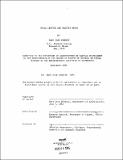Focal lengths and gravity waves
Author(s)
Doherty, Mary Jane
DownloadFull printable version (2.317Mb)
Alternative title
Gravity waves and focal lengths
Gravity
Other Contributors
Massachusetts Institute of Technology. Dept. of Architecture.
Advisor
Richard Leacock.
Terms of use
Metadata
Show full item recordAbstract
Film is composed of tiny photographs which, when projected, sometimes look very much like people and things in the real world. Film, too, cannot be separated from its tools. Aesthetic criticism was, and still is, weighted towards consideration of the life-like tiny photographs. This thesis traces the evolution of film technology in order to establish the point where non- fiction ideology (aesthetics) lost pace with technical innovation - a derailment, so to speak, with nefarious implications for the present-day filmmaker. The emphasis is on lenses - the provocative "camera eye" - and sound recording equipment - which proved to be the rate-limiter of technical advance. This thesis considers two filmmaking solutions to the present malaise; the Standard TV Documentary, and the single-person shooting methodology of former MIT filmmakers, Jeff Kreines and Joel DeMott - both of which, in turn , will be compared to my own response - in the form of a movie, Gravity, which is about the members of an MIT experimental astrophysics laboratory trying to discover gravity waves. A videotape copy of the movie. is included with the thesis paper.
Description
Thesis (M.S.V.S.)--Massachusetts Institute of Technology, Dept. of Architecture, 1985. MICROFICHE COPY AVAILABLE IN ARCHIVES AND ROTCH. Transferred to 1/2 in VHS videotape from 8 mm film. Includes bibliographical references (leaves 56-57).
Date issued
1985Department
Massachusetts Institute of Technology. Department of ArchitecturePublisher
Massachusetts Institute of Technology
Keywords
Architecture.